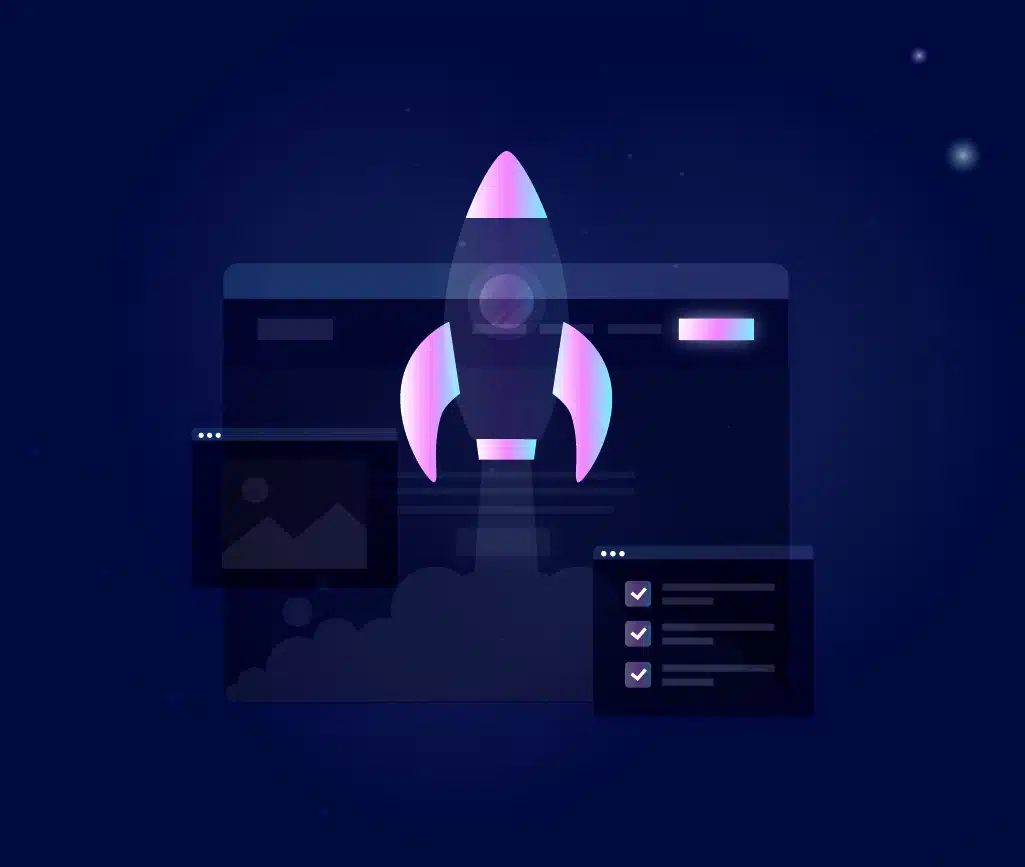User Experience
11 minute read
How to Use Dynamic Website Content in 2022.
LAST UPDATED:
August 15, 2023


In today’s digital world, every organization is striving to optimize the customer experience.
Although there are several approaches for accomplishing this, one tried-and-true method is to provide dynamic or personalized content as part of your comprehensive website design plan.
Whether you have a Shopify website, Webflow website, WordPress website, or any other type of site, dynamic content can make users feel welcome and greet them on the website whenever they visit.
While some people are ready to buy, others may want more details or simply like to look around and compare different products or services.
With dynamic content, these audiences can be reached in real-time.
In this article, we’ll discuss several ways to effectively add that extra personalization to your website via dynamic content.
The vast majority of today’s websites are in flux. Pages often change their content, layout, and functionality to cater to a wide range of users.
Even though two users’ requests are separated by only a fraction of a second, the content they are served can be totally different. This is referred to as dynamic content.
What Is Dynamic Content?

Dynamic content (or adaptive content) refers to content that creates a unique experience for users of your website.
Essentially, dynamic content adapts to the interests and needs of the people who are viewing it at any particular time, to attempt to reach each user where they are at in their customer journey.
There are different types of dynamic content like product pages, landing pages, forms, and articles used to display different interactive content based on customer data. The purpose is to draw customers to your website by presenting them with helpful, interesting, and relevant content.
User-tailored experiences are possible thanks to dynamically generated smart content that can be delivered in many ways.
For example, it could be based upon remembering the visitor’s name to greet them when they return to your homepage.
Alternatively, it may be able to remember previous purchases and be used in future product recommendations.
For this reason, ecommerce sites like Amazon implement dynamic content to recommend products that customers who have already purchased something similar might appreciate.
This is also how websites can promote themselves on other sites using their own generated ads.
If you’ve ever done a product search on one website in the morning and found the same or similar items on another website later in the day, this explains why!
What Is a Dynamic Page?
Dynamic web pages are those which allow users to interact with the content on them.
Whenever a user visits this page, the page remembers their preferences and utilizes that user data information to create engaging content experiences for them.
The next time a user accesses a dynamic page, data from the previous visits will completely customize the user experience.
One example of a dynamic page is the YouTube homepage. Think about how difficult it would be to go through all the videos added to YouTube every month to find the ones that are most relevant to you.
YouTube employs scripting to keep track of what you’ve searched for and what you’ve viewed or liked before.
Every time you return to their website, you’ll only see video recommendations tailored to your interests.
What Is Dynamic Content Marketing
Dynamic content marketing is a type of digital marketing that involves showing customized content to users based on their interactions with a company’s website. This content is designed to be relevant and interesting to the user, in hopes of prompting them to make a purchase.
Using a dynamic content marketing strategy allows companies to tailor their message to specific users. This results in a higher chance of increased conversion, as the user is seeing content that is relevant to their interests.
Ultimately, dynamic content marketing as a part of an overall online marketing strategy can be used to increase sales and boost conversions.
Static Content vs. Dynamic Content
If a dynamic content website exists, then static content does as well. Let’s discuss the differences between the two.

How Is Dynamic Content Generated?
Dynamic content is created via a database of stored information.
For example, the website remembers the user’s name whenever they return because of a database that organizes files of information.
User-provided data—such as names, email addresses, purchase history, and other personal details—serves as the source for this information.
For the most part, dynamic content for websites is driven by applications and server-side scripts. These apps work in tandem with the web server to process user requests, generate dynamic content, and then deliver that content to the user.
How Is Static Content Generated?
When a site user accesses static content, it means that it has not been generated, updated, or processed before it was delivered to them.
Static content is among the easiest and most efficient forms of online content because the server transmits the same files to every user.
A newspaper is a good analogy for static content. Anyone who purchases a copy of a newspaper will see the same stories and photos regardless of any events that may have occurred during the day.
When creating static content, HTML files are used.
Anything collected for dynamic web content is not used and disregarded.
Although static content is less engaging, it’s easier to store, parse, and deliver.
When it comes to marketing, consumers demand content based on customization.
According to 72% of shoppers, they only interact with marketing messages that are relevant to their interests.
In addition, 91% say they prefer to buy from companies that make recommendations that are specifically tailored to them.
What Is Personalization of Websites?
Website personalization is a method for tailoring the user experience based on the information gathered from dynamic content databases.
When a user visits a website, personalized recommendations are created based on the user’s previous browsing history and regular online habits.
This is determined by the data provided by the user, their demographics, their preferences, and so on.
The main objective of web personalization is to improve the customer experience by anticipating and meeting their needs and preferences before they are expressed.
How Can Personalization Be Implemented?

Personalization can be implemented using the information collected in databases. Reliable data is the foundation for creating personalized experiences.
Web content personalization works best when you know as much as possible about your guests.
Adding a personal touch using different forms of dynamic content is simple if you have the right data to work with. The good news is that you don’t have to be an expert in data collection to get the job done.
Finding out which type of content your website’s users want is as simple as using the appropriate tools and looking in the right places.
For instance, you can use cookies, contact forms, CTAs, and the like.
However, this needs to be done ethically. With more and more companies collecting data from their users every day, privacy has been a big ethical issue and a matter of debate for several years.
In fact, there have been several studies and even court cases surrounding the topic.
Users should be allowed to decide how much information they want to disclose and what data is collected.
As such, make it possible for them to opt out of sharing their information with you.
In other words, when implementing dynamic content on your web pages, make sure your users know what information they’re giving you and that you have their permission to do so.
In addition, although cookies are frequently used to gather information about users, several third-party services allow users to prohibit cookies from being added to their browsers.
Some web browsers have even incorporated features to block cookies and safeguard their users.
Getting the user’s consent is a good rule of thumb when dealing with personal information.
What Can You Do to Personalize Your Website?
Once you’ve decided that personalization is the right path to your website’s success, here are some steps you can take to implement it:
Learn More About Your Audience
You can’t relate to somebody if you don’t know their background.
As such, your first step will be to have a better understanding of your audience. You’ll be able to get a lot of information about your market thanks to personalization.
You will be able to determine the following things:
- Behavior: You’ll discover how your visitors use your website, what they’re looking at, and how they ended up there in the first place.
- Demographic: This is where you will learn who your customer is and where they are from. In the context of B2B website design, you can also learn more about their business, such as how many employees they have, the industry they operate in, and so forth.
- Contextual information: This includes information about your user’s situation, such as the device they are using to access your website, whether they are a first-time visitor or a returning one, and if they are an organic visitor or a referral visitor.
Using the information and data acquired, you can create different CTAs based on whether your website visitor matches the parameters such as company size, industry, and so on.
For instance, one CTA could direct users to contact your sales team, then another could direct them to sign-up for a free account.
Customize Testimonials
The easiest way to show your customers what you’re best in is to use customer testimonials. They serve as social proof, which builds your company’s trustworthiness and reliability, ultimately leading to better conversion rates.
Existing customer testimonials can be tailored to attract new ones.
For example, if your customer is B2B, share a B2B testimonial. In the same way, if your customer is an online shopper, show an ecommerce testimonial.
Feature Content That Is of Interest to Users
Content like blog posts, case studies, downloadables, and the like are excellent tools for educating potential buyers about your product or service.
By using personalization and the data collected, you can show those leads other content that interests them.
Customizing a user’s experience on your website is possible using firmographic data (such as the industry they work in) and behavioral data (such as the blog articles they’ve read).
Even from an ecommerce perspective, this is still the case!
Potential buyers can see items that appeal to them based on their past purchasing behavior, their most recent searches, or even items related to their earlier searches or purchases, among other factors.

Every website experience has its native user flows and paths that users can organically take. It can be extremely effective to be able to leverage dynamic content to force certain content/imagery to appear so that the overall experience is more personalized. This can be done through a series of behavior triggers as well as A/B tests.
Mike Cleary, Co-Founder
Benefits of Personalization
As more and more companies are personalizing their online presence, let’s look at how you can take advantage of this technique to increase your sales and improve your marketing and lead generation efforts.
Here are a few of the many benefits of website content personalization:
Personalization Can Increase Customer Numbers and Brand Loyalty
The most important benefit of site personalization for your customers is the ability to recommend content or products that match their needs.
Based on the data you collect from your customers, you can accurately predict what they want to buy next.
Customers are more inclined to buy from your website if they know they will be shown things they are interested in rather than products that have little or no meaning.
The more satisfied your customers are with your products, the more likely they will remain loyal to your business and even suggest you to their friends and family. It’s only natural that you’d want to spend more time with those treating you well.
All of us appreciate excellent customer service, and it’s a major factor in brand loyalty. The same is true for web personalization.
Protip
Creating a warm, friendly, and personalized experience for your visitors will help them become more loyal to you.
Personalization Lends Itself to Customers Actively Staying On Your Website Longer
If you catch the customer’s attention with a recommended product that interests them, they will be more likely to stay on your website longer and come back more often.
Humans are wired to pay greater attention to what excites them, but our attention spans are only eight seconds long. And as people, we are very interested in ourselves.
By reflecting your customers’ purchasing behavior and hidden patterns back to them, your website’s visitors are more likely to stick around for a longer time.
Almost every marketer keeps an eye on the length of time visitors spend on a website because it’s a good indicator of how engaged they are.
Personalization gives you the chance to get to know your customers.
By having a deeper understanding of your customers and their needs and wants, you can better serve them.
This opens the door to the creation of dynamic content that keeps your customers interested and engaged throughout their whole experience with your brand.
When developing landing pages for your own website, you may use these ideas to draw in potential employees with your Careers page or captivate customers with your About Us page design.
Regardless of who you’re trying to reach with your personalized website, the goal should always be to improve the user’s experience and provide tangible benefits to your visitors.
If you’re able to demonstrate your company’s value to a potential lead, you’ll have a better shot at winning them over as a customer.
Here are some best practices and further info on dynamic content marketing, web development and website design. If you have further questions don’t hesitate to reach out.
Dynamic Website Content FAQ
Questions about dynamic content? We try to answer them here.
What are examples of dynamic websites?
A dynamic website is a site that changes in response to user input.
There are many different types of dynamic websites, but some common examples include ecommerce sites, social networking sites, and content management systems.
- Ecommerce sites allow users to browse and purchase products online
- Social networking sites allow users to connect with friends and share updates.
- Content management systems, on the other hand, provide a way for businesses to easily create and update their website content.
While dynamic websites require more development effort than static websites, they offer a much richer user experience. As a result, dynamic websites are becoming increasingly popular as people spend more time online.
Further Reading On Website Design and Development.
Looking for web development and design inspiration? These articles should help.
- How Much Does It Cost to Build a Website?
- A Step-by-Step Website Redesign Project Plan
- Our Approach to WooCommerce Web Design
- How to Build a Web Design System
- WooCommerce vs Shopify: Who Comes Out as a Winner?
- Why We Excel at Website Redesign
- Choosing the Right Product Metrics Using UX Research Process
- Our Top Retail Website Examples
- Understanding Web Design and Web Development
- Our Top Beauty Website Examples
- The Importance of Shopify Speed Optimization
- Our Shopify Speed Guide Checklist
- Guide to Optimizing Shopify Image sizes
- Our Service Page Layout Examples
- Best SaaS Websites of 2022
- New Website SEO Foundations
- Our Approach to Startup Website Design and Development
- WordPress Performance Optimization Best Practices
- 100 Ecommerce Website Design Tips
Get Memorable Insights.
Sign up to receive actionable web design advice directly in your inbox monthly.
Get Memorable Insights.
Sign up to receive actionable web design advice directly in your inbox monthly.
Author
Jeff Gapinski is the President of Huemor where he helps plan the long-term strategic growth of the agency. Jeff is passionate about UI/UX, demand generation, and digital strategy.
What Do You Think?
Have feedback? Maybe some questions? Whatever it is, we'd love to hear from you.




![Website Design Standards We Follow [That You Should Too!]](https://huemordev.b-cdn.net/wp-content/uploads/2021/12/2023.04.04.Website-Design-Standards-We-Follow-That-You-Should-Too.jpg.webp)



No comments found